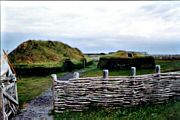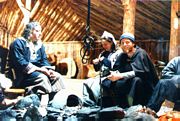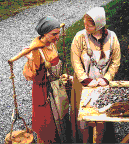
Home and Hearth - the Norse at Home
Throughout the Norse world, houses were built on a similar floor plan - the longhouse.
The basic structure was a long thin rectangle, divided into rough thirds by two
long lines of roof posts. The central floor area would be the location for a large
fire, usually set on a raised hearth several inches high. The fire was the source
of heat and most of the interior light, as well as serving as the kitchen. The
area along each wall was typically made into a wide bench formed of wooden planks.
These were the major furniture, used for seating during the day and sleeping pallets
at night. The interior of the house might be broken by a few partition walls,
but normally everyone lived together in the single main room or hall. The roof
could be pierced by rectangular smoke vents, sometimes only gaps in the gable
walls served to clear the smoke. The actual construction materials varied by what
was locally available. In southern areas, walls of woven saplings plastered with
mud, called 'wattle and daub' were common. In heavily forested areas, the side
walls might be made of planks or even squared timbers. In either case, the roofing
material was likely to be thick straw thatch. In the close packed towns, narrow
lots left almost no space between houses. The combination of open fires and thatch
roofs resulted in wide ranging fires as a common hazard. To the North, and later
to the West, the walls were composed of thick piles of turf blocks, both sturdy
and an excellent insulator. Poles set over the roof timbers supported more turf
covered with living grass sod to stabilize it. Looking more like a low hill with
short earthen walls, such turf longhouses would be the standard in Iceland and
Greenland - and were the type built by Leif in Vinland.

What was day to day life like in the Viking Age? In a word - hard! Inside the house,
it would always be smoky and dark. Although a turf house is 'relatively' snug from
the outside elements, it would still be cold and drafty by our standards. And most
of all, it would be crowded. The number of people living in a hall would be determined
by how many bodies could be fit on the sleeping benches. Privacy was virtually nonexistent.
Perhaps you could string a couple of cloaks between the roof timbers, but only the chieftain
of the household was likely to have a private room at one end of the hall.
Only the very wealthy would have a separate bed. For most people, all that they owned
could fit in a small sea chest - or on their own body. Activities indoors would gravitate
towards the central fire, it was only here that there would be heat - and light.
In the winter, there would be a constant fight to keep warm. When it rained, you
got wet. There were no waterproof materials in the Viking Age. Disease could spread
rapidly through a crowded hall, even the slightest injury could lead to infection and
death.

The activities outdoors where determined by the cycle of the sun and the progress
of the seasons. Daylight meant work time, long hours in the summer, short days come
mid winter. Each was punctuated by two meals, one in mid morning after a couple of
hours labour and a second at the end of the evening. Spring was time for planting and caring
for newborn animals. Mid Summer time of building ships and houses, perhaps opportunity
for a raid. Fall was occupied with the harvest, thinning the herds, and preparing foods for
storage. Winter might see some felling of timber and traveling, but mostly
was a battle against snow , wind and potential hunger.
Food for the Pot:
Even still, the crofting system used by the Norse of raising animals, hay and some
crops, served them well. Sheep, goats and cattle were raised more for their secondary
products, fleece and milk, than for their meat. The vast northern forests sheltered
game for the hunters, deer, elk and reindeer as well as birds, ducks and geese. Sailors
were also hunters and fishermen: wales, seals and fish of all types were harvested.
Taken altogether, the Norse had a higher protein content to their diets than their
southern neighbors. The most direct result of this was that they were larger and stronger
- a significant factor in a world where success in combat was largely based on physical
size.
Wheat did not tolerate the northern climates well, the main grain crops were barley,
oats and rye. Peas were also grown to grind into flour. The resulting mixture
would seem strange to our taste, and further, bread was most commonly baked on
open fires without yeast to raise it. The result is more like a cracker or pancake
than what we would think of as bread - ovens were uncommon. Since grains were
stored dried, thick porridge was a normal meal. Preserving meats and fish meant
either salting or drying them. Preparing these ingredients for a meal was easiest
by boiling. Large cauldrons of iron or bronze sheet would hang from decorative
iron chains in the hall, working as an 'endless stew pot'. Salt fish yesterday,
wild duck today, a bit of old mutton tomorrow, all cooked with a handful of barley,
some chopped onions and turnips and a few dried mushrooms and herbs. Each day's
leftovers formed the base for the next meal. Hail to the hunters! A fresh roast
of seal or deer, roasted on an iron spit or huge fork, would be a welcome addition.
Add cheeses from runny to old, and lots of salted butter. Top it all off with
plentiful beer, or if you are trying to impress, with honey mead or even imported
wine.
 Clothes make the man?
Clothes make the man?
The responsibilities of a woman of status included home and hearth and all that
affected it. Primary amongst these were all the arts related to textiles, from
rough fleece to final embellishment of a garment. Not a set of skills to be taken
for granted, and basic to survival of the household through winter months. The
types of domestic animals raised by the Norse were smaller and less specialized
than what we farm today, what we would refer to as the 'ancient breeds' such as
Icelandic and Jacobs sheep. These animals produced fleece, milk and meat, each
animal going through a cycle of use during its life. Most sheep in the Viking
Age were spotted, producing white, brown and black fleece. To produce a full range
of colours, various plant and lichen dyes were used, some gathered wild, some
purposefully grown. Browns, yellows and oranges were likely dominant, for these
colours are easiest to produce. Special dye plants, and especially certain lichens,
can yield up blues, reds - even purples.
After dyeing, the washed fleece would be combed to straighten the fibers and clean
out any 'lumps'. Then the wool was spun into thread using a simple drop spindle,
which twists the individual fibers together. The amount of labour required for
this process is nothing short of incredible - the amount of thread required for
a single cloak can be measured by the kilometer! Once a quantity of thread was
produced, it would be strung on to a large rectangular frame, which leaned against
a wall - the standing loom. On this the cloth would slowly take shape. The Norse
women were so proficient at the production of high quality wool cloth that a standardized
weight and measure of such formed a basic Viking Age trade good, called 'wadmal'.

Wool for warmth would be combined with imported linen (from flax) used for under
garments. The wealthy might be able to purchase rare silk, imported from the Far
East up the eastern trade routes. These all would be combined to create the primary
clothing style of the period, called the 'T' tunic because of its basic shape.
The typical woman's dress would consist of an under gown that was snug through
the arms and flared from the chest to about ankle length. An over gown, usually
of a contrasting colour, would come next, usually cut to about mid calf lenght
and with slightly fuller and shorter sleeves. On top of this all would be worn
a rectangular apron with straps over the shoulders secured with brooches for a
woman of possessions. Men's clothing was similar, only with the tunics shortened
to mid thigh length and worn over pants. Both sexes would finish off with a belt
and simple leather shoes, plus a rectangular cloak for outdoor wear.

Decorative woven bands, produced by a method using square cards called tablet
weaving, both strengthened seams and added a splash of colour. Embroidery with
coloured threads could decorate hems and necklines. Thicker wool could be turned
into socks, mittens or caps using a technique of single needle knitting called
'nalebinding'. A small leather pouch might be found on the belt, and a small knife
would be worn by all. These were considered the basic tools of daily life, weapons
were swords, axes or spears. All the Norse were fond of jewelry, from the simple
wooden plaques of poor farmers to the intricate master works in gold worn by kings.
Glass beads, with their bold patterns and bright colours, were extremely popular,
although primarily worn by women. Silver, gathered in raids from Europe, flooded
the market during the Viking Age. Bracelets, chains and amulets of silver were
fashioned so that the successful could 'wear the bank' and display their wealth.

Life in Scandinavia at the turn of the first millenium was obviously more complex
that this simple picture presents, but if there was an "average Viking" - what
would their daily life be like? Life was harsh, but the Norse met the challenge
with energy and resourcefullness. Most lived in large household groups, farming
and hunting for their daily needs, often with surplus left over to trade for luxury
goods. The old days of raids were gone, and a growing number were living in the
relatively new towns that owed their existance to that same trade that had sprung
up in its place.
go on to part three....
 Dark Ages Re-Creation Company
Dark Ages Re-Creation Company







